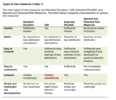Sixcarbs
Active Member
Hi, this is not about specific question but about the concept of Monotonicity. It did not seem intuitive to me when I read it and I was hoping it was an error, but I just watched the video and it is the same.
IF Y>=X then rho(Y) <= rho (X)
If Y returns more than X, than the risk of Y must be less than the risk of X.
Why would anyone invest in X if they can do better with Y for less risk? It just seems to counter everything we have been discussing.
Thanks
Further thoughts: Or does this mean that the VaR(Y) has to be less than or equal to the VaR(X)? Even so, why ever invest in X?
IF Y>=X then rho(Y) <= rho (X)
If Y returns more than X, than the risk of Y must be less than the risk of X.
Why would anyone invest in X if they can do better with Y for less risk? It just seems to counter everything we have been discussing.
Thanks
Further thoughts: Or does this mean that the VaR(Y) has to be less than or equal to the VaR(X)? Even so, why ever invest in X?
Last edited:



